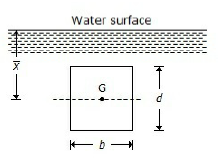The buoyancy depends on
Mass of liquid displaced
Viscosity of the liquid
Pressure of the liquid displaced
Depth of immersion
Correct Answer :
A. Mass of liquid displaced
Related Questions
Newton's law of viscosity is a relationship between
Pressure, velocity and temperature
Shear stress and rate of shear strain
Shear stress and velocity
Rate of shear strain and temperature
The kinematic viscosity of an oil (in stokes) whose specific gravity is 0.95 and viscosity 0.011 poise, is
0.0116 stoke
0.116 stoke
0.0611 stoke
0.611 stoke
The most efficient section of a channel is
Triangular
Rectangular
Square
Trapezoidal
When a cylindrical vessel containing liquid is revolved about its vertical axis at a constant angular velocity, the pressure
Varies as the square of the radial distance
Increases linearly as its radial distance
Increases as the square of the radial distance
Decreases as the square of the radial distance
A vertically immersed surface is shown in the below figure. The distance of its centre of pressure from the water surface is 
(bd²/12) + x
(d²/12 x) + x
b²/12 + x
d²/12 + x
A tank of uniform cross-sectional area (A) containing liquid upto height (H1) has an orifice of cross-sectional area (a) at its bottom. The time required to empty the tank completely will be
(2A√H₁)/(Cd × a√2g)
(2AH₁)/(Cd × a√2g)
(2AH₁3/2)/(Cd × a√2g)
(2AH₁²)/(Cd × a√2g)
An object having 10 kg mass weighs 9.81 kg on a spring balance. The value of 'g' at this place is
10 m/sec²
9.81 m/sec²
9.75 m/sec²
9 m/sec
The discharge in an open channel corresponding to critical depth is
Zero
Minimum
Maximum
None of these
The time oscillation of a floating body with increase in meatcentric height will be
Same
Higher
Lower
Lower/higher depending on weight of body
The centre of gravity of the volume of the liquid displaced by an immersed body is called
Centre of gravity
Centre of pressure
Metacentre
Centre of buoyancy
The torque required to overcome viscous resistance of a collar bearing is (where R1 andR2 = External and internal radius of collar)
(μπ²N/60t) × (R₁ - R₂)
(μπ²N/60t) × (R₁² - R₂²)
(μπ²N/60t) × (R₁³ - R₂³)
(μπ²N/60t) × (R₁⁴ - R₂⁴)
Piezometer is used to measure
Pressure in pipe, channels etc.
Atmospheric pressure
Very low pressures
Difference of pressure between two points
For a body floating in a liquid the normal pressure exerted by the liquid acts at
Bottom surface of the body
C.G. of the body
Metacentre
All points on the surface of the body
The most economical section of a rectangular channel is one which has hydraulic mean depth or hydraulic radius equal to
Half the depth
Half the breadth
Twice the depth
Twice the breadth
A square surface 3 m × 3 m lies in a vertical line in water pipe its upper edge at water surface. The hydrostatic force on square surface is
9,000 kg
13,500 kg
18,000 kg
27,000 kg
The water pressure per metre length on a vertical masonry wall of dam is (where w = Specific weight of the liquid, and H = Height of the liquid)
wH/2
wH
wH2/2
wH2/4
The total energy of a liquid particle in motion is equal to
Pressure energy + kinetic energy + potential energy
Pressure energy - (kinetic energy + potential energy)
Potential energy - (pressure energy + kinetic energy
Kinetic energy - (pressure energy + potential energy)
A ship whose hull length is 100 m is to travel at 10 m/sec. For dynamic similarity, at what velocity should a 1:25 model be towed through water?
10 m/sec
25 m/sec
2 m/sec
50 m/sec
A Piezometer tube is used only for measuring
Low pressure
High pressure
Moderate pressure
Vacuum pressure
Steady flow occurs when
The direction and magnitude of the velocity at all points are identical
The velocity of successive fluid particles, at any point, is the same at successive periods of time
The magnitude and direction of the velocity do not change from point to point in the fluid
The fluid particles move in plane or parallel planes and the streamline patterns are identical in each plane
A structure used to dam up a stream or river over which the water flows is called
Orifice
Notch
Weir
Dam
The loss of pressure head in case of laminar flow is proportional to
Velocity
(Velocity)2
(Velocity)3
(Velocity)4
The pressure in Pascals at a depth of 1 m below the free surface of a body of water will be equal to
1 Pa
91 Pa
981 Pa
9810 Pa
The buoyancy depends on
Mass of liquid displaced
Viscosity of the liquid
Pressure of the liquid displaced
Depth of immersion
Kinematic viscosity is equal to
Dynamic viscosity/density
Dynamic viscosity × density
Density/dynamic viscosity
1/dynamic viscosity × density
Coefficient of resistance is the ratio of
Actual velocity of jet at vena-contracta to the theoretical velocity
Area of jet at vena-contracta to the area of orifice
Loss of head in the orifice to the head of water available at the exit of the orifice
Actual discharge through an orifice to the theoretical discharge
The fluid forces considered in the Navier Stokes equation are
Gravity, pressure and viscous
Gravity, pressure and turbulent
Pressure, viscous and turbulent
Gravity, viscous and turbulent
A uniform body 3 m long, 2 m wide and 1 m deep floats in water. If the depth of immersion is 0.6 m, then the weight of the body is
3.53 kN
33.3 kN
35.3 kN
None of these
The theoretical velocity of jet at vena contracta is (where H = Head of water at vena contracta)
2gH
H × √(2g)
2g × √H
√(2gh)
The Francis formula for the discharge over Cipoletti weir is
1.84 LH1/2
1.84 LH
1.84 LH3/2
1.84 LH5/2
